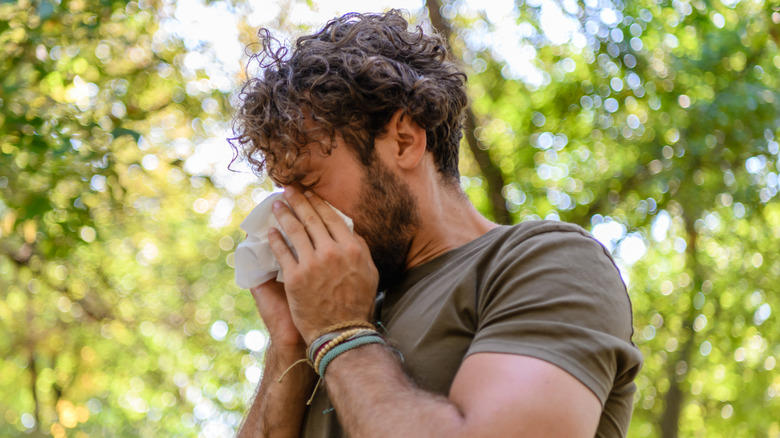What It Means When Your Nose Burns
You just haven't been feeling yourself lately. In addition to feeling more tired than usual, your nose has been burning and running. A slight cough has also developed. With a burning nose, cough, congestion, and possibly fever, you're looking at a viral infection.
According to the Mayo Clinic, a viral infection is a microscopic germ that enters your system. Once it gets all cozy in your nose and throat, it replicates and makes you sick. The flu, common cold, and even COVID-19 are all examples of viral infections. These viruses make your nose run, but also contribute to that burning feeling inside your nasal passages. As it runs, you blow and wipe your nose, irritating the skin and giving you a red-nose look. Viral infections generally don't have a cure and typically need to run their course. Rest, fluids, and over-the-counter medications can help combat their symptoms.
While a viral infection is a common cause of a burning nose, this symptom can also be part of allergies, non-allergic rhinitis, rhinitis medicamentosa, sinusitis, and frostbite. Explore the symptoms and treatment of each condition and why they make your nose burn.
Burning nose linked to hay fever
There are substances in this world that your immune system just doesn't like. The World Allergy Organization notes that 10% to 30% of adult Americans suffer from allergic rhinitis (hay fever). You might also call these seasonal allergies.
Allergic rhinitis happens when the body develops an immune system reaction to an ordinary environmental substance, like pollen. Therefore, the moment you breathe pollen in, your nose gets inflamed. You start to experience burning, itching, and stuffiness. Your eyes can even water and feel itchy as well. Allergic rhinitis can be seasonal (e.g., allergies to pollen, grass, and weeds, which come out in the spring). Some people have perennial allergic rhinitis that happens all year long, like mold, dust mites, and dander allergies, per the American College of Allergy, Asthma, & Immunology.
Regardless of the trigger, avoiding it is vital to mitigating your symptoms. Refrain from going outdoors when pollen is high, and wear glasses to prevent pollen from entering your eyes. Indoor allergens can be avoided by cleaning your house and taking precautions, like mite-proof bed and pillow covers. Antihistamines and nasal solutions can help treat the symptoms of allergens that find their way into your nose (via NHS Inform). Those with severe allergies might even require allergy shots and prescription tablets.
Non-allergic rhinitis can cause burning in and around the nose
Your burning and drippy nose has been plaguing you for months, but your allergist's test returned nothing. In this case, you're likely dealing with non-allergic rhinitis. This sneaky condition causes inflammation and burning in the nose, but there doesn't seem to be a specific allergen making you miserable. Instead, various triggers could be causing the sneezing and drippy nose, like weather changes, exercise, stress, medication, dust and fumes, and even foods, per the Mayo Clinic.
According to American Family Physician, chronic non-allergic rhinitis accounts for 23% of rhinitis cases in the U.S. It also typically hits adults after age 20. This diagnosis coincides with a negative allergy test and common allergy symptoms like watery eyes, stuffy nose, inflammation, and itchiness. Additionally, non-allergic rhinitis can also be intermittent, persistent, or seasonal.
Since the cause of this condition is hard to track down, it can be harder to treat. However, the Cleveland Clinic states that humidifiers, nasal washes, and antihistamines can help reduce inflammation. American Family Physicians also notes that internasal corticosteroids, like fluticasone, can be more helpful in controlling inflammation in those with non-allergic rhinitis.
Overuse of nasal sprays has a nose-burning effect
Using nasal sprays can help clear the inflammation and make your nose feel better and less burny. However, overuse of nasal sprays creates issues. So, having balance is key to keeping that burning and itchy nose at bay.
Rhinitis medicamentosa is the medical name for rebound congestion from the overuse of nasal sprays. This condition creates inflammation in the nose without the presence of allergens, triggers, or a virus. It affects anyone who uses nasal sprays or gels for more than seven to ten days, according to the Cleveland Clinic. When you squirt the spray or gel into your nose, it irritates the lining of the nose due to the buildup of the product, creating the symptoms you're trying to avoid.
Since the spray is causing the swelling, Healthline recommends gradually decreasing your medication use by using saline sprays rather than the decongestant. Steroids might also be prescribed to help. Inflammation will eventually go down after the medication is discontinued. Prevention of this condition requires reading labels carefully and only using the medications as recommended, especially according to the duration of the medication.
Get checked to see if sinusitis is to blame
Treating your cold or allergies helps to avoid it morphing into something more sinister and painful. Sinusitis, or sinus infection, is caused by a virus, bacteria, or fungus and presents with a burning and irritated nose, stuffiness, postnasal drip, pain and pressure in the face, nose, and eyes, fatigue, and fever (per Medline Plus). The Cleveland Clinic states that the pain you feel from a sinus infection can also worsen with head motions or when you try to pick something up.
While colds and allergies are common causes of a sinus infection, smoking, sinus abnormalities, cystic fibrosis, and other diseases can also contribute to chronic infections. According to WebMD, approximately 35 million people suffer from sinus infections in the United States each year. Diagnosis can require a simple check-up by your provider to look up the nose and examine your symptoms. Chronic sinusitis sufferers might also have CT scans, nasal cultures, and other testing to look at the structures and functions of the nasal cavity.
Treatment for this condition depends on the specific cause. Viral infections might be treated at home by applying a warm compress, using saline to thin mucus and clear blockages, and inhaling steam to open the cavity, according to the Centers for Disease Control and Prevention. Your provider might also prescribe antibiotics to help clear out bacterial infections. Fungal infections and severe sinusitis issues may require surgery.
Frostbite leads to nose burning
Frostbite is a painful condition that affects your body's extremities when exposed to extreme cold. NHS states that it can happen at any temperature below 31 degrees Fahrenheit. While frostbite can occur anywhere, it's most common on the nose, lips, feet, hands, and ears. The symptoms of frostbite to look for include burning, skin that's pale and hard, swelling, and possibly blisters.
Frostbite happens because our body constricts the vessels when the skin is cold to allow more blood movement to the vital organs. So, areas like your nose can freeze, damaging the cells and tissues. Severe frostbite can lead to infections and tissue death, meaning it must be removed. Therefore, you must warm your nose slowly when it experiences frostbite. Johns Hopkins Medicine suggests getting warm as soon as possible, washing your nose, and bandaging it if needed. You'll also want to avoid getting the area cold again since this can further damage the skin. The American Academy of Orthopaedic Surgeons also recommends avoiding rubbing the area or using heating pads to warm it up since numb skin can be damaged easily.
Frostbite on your nose is preventable by covering the area properly when going out in cold temperatures. For example, wear a scarf or face mask to warm the area. You'll also want to get inside if you get wet. Additionally, caffeine and alcohol leave the skin more open to injury.






